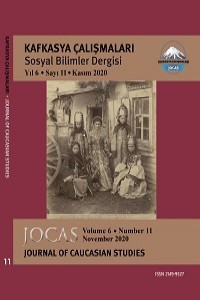Social Revolution in Circassia: The Interdependence of Religion and the World-System [Çerkesya’da Sosyal Devrim: Dinin ve Dünya Sisteminin Birbirine Bağımlılığı]
: Çerkesler, Kafkasya, marksizm, dünya sistemi, sosyal yapı
Social Revolution in Circassia: The Interdependence of Religion and the World-System [Çerkesya’da Sosyal Devrim: Dinin ve Dünya Sisteminin Birbirine Bağımlılığı]
Circassians, Caucasus, Marxism, World-system, Social structure,
___
- Althusser, Louis. “Ideology and Ideological State Apparatuses”. London: Verso, 2014
- Amin, Samir. “Global History: A View From the South”. Cape Town: Pambazuka Press, 2011.
- Bell, James Stanislaus, Journal of a Residence in Circassia, during the years 1837, 1838, and 1839, 2 vols. (London, 1840)
- Bernstein, William J. A Splendid Exchange: How Trade Shaped the World. Berkley, CA, 2008.
- Egger, Vernon. “A History of the Muslim World to 1750: The Making of a Civilization”. 2nd ed. New York City; Routledge, 2018.
- Hansen, Lars. F. “The Circassian Revival: A Quest for Recognition: Mediated transnational mobilisation and memorialisation among a geographically dispersed people from the Caucasus”. Københavns Universitet, Det Humanistiske Fakultet, 2014.
- Henze, B Paul. “Circassian Resistance to Russia,” in Marie Bennigsen Broxup ed., The North Caucasus Barrier, London: Hurst & Company, 1996.
- Ilgener, Ahmet. “Turkey and the North Caucasus: an Analysis of Internal and Domestic Relations. Masters Thesis, Naval Postgraduate School, 2013.
- Jordet, Nils. "The Frozen Conflict Between the United States and Iran: Causal Patterns Prior to the Coup D'etat of 1953 and the Contemporary Attitudes of Hostility." Tufts University, 2002. AAT
- King, Charles, “Imagining Circassia: David Urquhart and the Making of North Caucasus Nationalism,” Russian Review 66, no. 2 (April 2007): 238–55
- Kreiten, Irma (2009). “A colonial experiment in cleansing: the Russian conquest of Western Caucasus, 1856–65”. Journal of Genocide Research, 11:2-3, 213-241
- Longworth, John A., A Year among the Circassians, 2 vols. (London, 1840)
- Manning, Paul. "Just like England: On the Liberal Institutions of the Circassians." Comparative Studies in Society and History 51, no. 3 (2009): 590-618.
- Marx, Karl. The Eighteenth Brumaire of Louis Bonaparte. New York: International Publishers, 2015
- Marx, Karl, “Economic and Philosophic Manuscripts of 1844,” in Robert C. Tucker ed., Marx-Engels Reader. New York, London: W.W.Norton and Company, 1978. P. 66-125.
- Marx, Karl, “Marx on the History of his Opinions,” in Robert C. Tucker ed., Marx-Engels Reader. New York, London: W.W.Norton and Company, 1978. P. 3-6.
- Richmond, Walter (2013). The Circassian Genocide. New Brunswick: Rutgers University Press, 2013.
- Zhemukhov, Sufian N. (2011) One Thousand Years of Islam in Kabarda, Anthropology & Archeology of Eurasia, 49:4, 54-71.
- ISSN: 2149-9527
- Yayın Aralığı: Yıllık
- Başlangıç: 2015
- Yayıncı: Murat TOPÇU
The Mountain Jews and the Nazi Occupation of Kabarda [Dağ Yahudileri ve Nazilerin Kabardey’i İşgali]
Yakındoğu’daki Osetler: Yerleşim, Uyum, Etnik ve Sosyal Evrim
Georgy CHOCHİEV, Çevirmen: Murat TOPÇU
Setenay SHAMİ, Çevirmen: Jade Cemre ERCİYES, Çevirmen: Zeynel Abidin BESLENEY
İMAM ŞAMİL'İN ÇERKESYA NAİBİ MUHAMMED EMİN’İN KUZEYBATI KAFKASYA’DAKİ FAALİYETLERİ (1848-1859)
